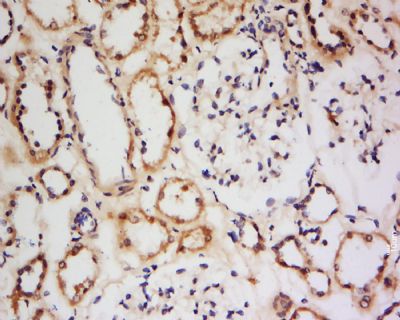CNGB3,环核苷酸门控阳离子通道蛋白β3/CNG-β3抗体
产品名称: CNGB3,环核苷酸门控阳离子通道蛋白β3/CNG-β3抗体
英文名称: Anti-CNGB3 antibody
产品编号: HZ-12094R
产品价格: null
产品产地: 中国/美国
品牌商标: HZbscience
更新时间: 2023-08-17T10:24:20
使用范围: WB,ELISA,IHC-P,IHC-F,IF
- 联系人 : 鲍丽雯
- 地址 : 上海市闵行区闵北路88弄1-30号第22幢AQ136室
- 邮编 : 200612
- 所在区域 : 上海
- 电话 : 139****0749
- 传真 : 021-60345367
- 邮箱 : www.shzbio.net
CNGB3,环核苷酸门控阳离子通道蛋白β3/CNG-β3抗体
产品编号HZ-12094R
英文名称CNGB3
中文名称环核苷酸门控阳离子通道蛋白β3/CNG-β3抗体
别 名ACHM1; ACHM3; Achromatopsia (rod monochromacy) 3; CNG channel beta-3; CNGB3; CNGB-3_HUMAN; Cone photoreceptor cGMP-gated cation channel beta-subunit; Cone photoreceptor cGMP-gated channel subunit beta; Cyclic nucleotide gated channel beta 3; Cyclic nucleotide-gated cation channel beta-3; Cyclic nucleotide-gated cation channel modulatory subunit; Cyclic nucleotide-gated channel beta-3; RMCH; RMCH1.
说 明 书0.1ml 0.2ml
研究领域细胞生物 神经生物学 通道蛋白 细胞膜受体
抗体来源Rabbit
克隆类型Polyclonal
交叉反应Human, Mouse, Rat, Chicken, Horse,
CNGB3,环核苷酸门控阳离子通道蛋白β3/CNG-β3抗体产品应用WB=1:100-500 ELISA=1:500-1000 IHC-P=1:100-500 IHC-F=1:100-500 ICC=1:100-500 IF=1:100-500 (石蜡切片需做抗原修复)
not yet tested in other applications.
optimal dilutions/concentrations should be determined by the end user.
分 子 量92kDa
细胞定位细胞膜
性 状Lyophilized or Liquid
浓 度1mg/1ml
免 疫 原KLH conjugated synthetic peptide derived from human CNGB3
亚 型IgG
纯化方法affinity purified by Protein A
储 存 液0.01M TBS(pH7.4) with 1% BSA, 0.03% Proclin300 and 50% Glycerol.
保存条件Store at -20 °C for one year. Avoid repeated freeze/thaw cycles. The lyophilized antibody is stable at room temperature for at least one month and for greater than a year when kept at -20°C. When reconstituted in sterile pH 7.4 0.01M PBS or diluent of antibody the antibody is stable for at least two weeks at 2-4 °C.
CNGB3,环核苷酸门控阳离子通道蛋白β3/CNG-β3抗体PubMedPubMed
产品介绍background:
Cyclic nucleotide-gated (CNG) cation channels are heteromeric complexes made up of principal alpha and modulatory beta subunits. The alpha subunits consist of CNG1-3 and form functional cation channels by themselves. The beta subunits consist of CNG4-6 and, unlike the alpha subunits, do not form functional channels, but rather modify the properties of channels. formed by CNG1-3. CNG channels are essential components of olfactory and visual transduction. CNG proteins are present in cone and rod photoreceptors and in the pineal gland, and they contribute to modulating arterial blood pressure. CNG6, also designated cyclic-nucleotide-gated cation channel beta 3 (CNG-beta 3), is an integral membrane protein that can form a heterooligomeric complex with CNG-3. CNG-beta 3 is activated by cGMP and this activation leads to the depolarization of rod photoreceptors as a result of cation channel being opened. CNG-beta 3 is expressed in a small group of retinal photoreceptor cells and in testis. Mutations in the gene encoding for CNG-beta 3, can cause achromatopsia, an autosomal recessively inherited disease characterized by low visual acuity, photophobia, a lack of color discrimination, and nystagmus.
Function:
Visual signal transduction is mediated by a G-protein coupled cascade using cGMP as second messenger. This protein can be activated by cGMP which leads to an opening of the cation channel and thereby causing a depolarization of rod photoreceptors. Induced a flickering channel gating, weakened the outward rectification in the presence of extracellular calcium, increased sensitivity for L-cis diltiazem and enhanced the cAMP efficiency of the channel when coexpressed with CNGA3 (By similarity). Essential for the generation of light-evoked electrical responses in the red-, green- and blue sensitive cones.
Subunit:
Heterooligomeric complex with CNGA3.
CNGB3,环核苷酸门控阳离子通道蛋白β3/CNG-β3抗体Subcellular Location:
Membrane; Multi-pass membrane protein.
Tissue Specificity:
Expressed specifically in the retina.
DISEASE:
Defects in CNGB3 are the cause of Stargardt disease type 1 (STGD1) [MIM:248200]. STGD is one of the most frequent causes of macular degeneration in childhood. It is characterized by macular dystrophy with juvenile-onset, rapidly progressive course, alterations of the peripheral retina, and subretinal deposition of lipofuscin-like material. STGD1 inheritance is autosomal recessive.
Defects in CNGB3 are the cause of achromatopsia type 3 (ACHM3) [MIM:262300]; also known as Pingelapese blindness. ACHM3 is a congenital complete achromatopsia and is distinct from total colorblindness mainly because of the consistent concurrence of severe myopia.
Similarity:
Belongs to the cyclic nucleotide-gated cation channel (TC 1.A.1.5) family.
CNGB3 subfamily.
Contains 1 cyclic nucleotide-binding domain.
Gene ID:
54714
Database links:
Entrez Gene: 54714 Human
Omim: 605080 Human
SwissProt: Q9NQW8 Human
Unigene: 154433 Human
Important Note:
This product as supplied is intended for research use only, not for use in human, therapeutic or diagnostic applications.

